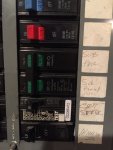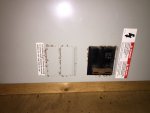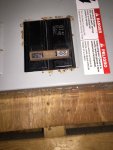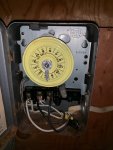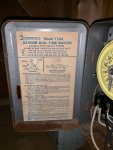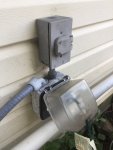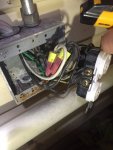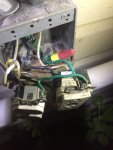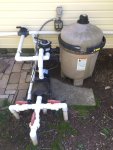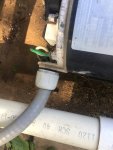I'm in the process of replacing my pump motor, and am rewiring/replacing the rusted out junction boxes, conduit and corroded switch and receptacles near my pump. The previous owner/pool installer has a 20A breaker in the sub panel than runs to an Intermatic T104 timer. The timer then goes outside the shed to a switch (manual switch) and then to a GFCI receptacle, then a standard receptacle, and then to the pump motor.
Assuming my current motor is running @ 230v (based on seeing the T104, but I will test with multimeter as well), is it ok to run the 230v through the switch, GFCI and regular outlet (existed GFCI receptacle is 125v) to the 230v motor? Just trying to understand if the higher voltage passing through from timer to motor needs to pass through switches/receptacles all rated at 230v as well.
Additionally, the wiring used is like Frankenstein's monster. Looks like an air conditioner whip (flexible conduit with wiring pre-installed) was used to connect the motor to the receptacle. On the surface it looks fine, but it must be 10 or 8ga stranded wire in that whip, while the receptacles appear to be connected with 12ga solid, then 10 or 12ga stranded wire connects the GFCI to the switch, and the switch appears to have 12ga solid going back to the timer. In short, a mess and next to impossible to connect everything cleanly and fit it in the junction box. Given that I have a 20A two-pole breaker in my subpanel that feeds all of this, is it safe to say that 12ga solid wire from timer to pump motor will suffice? Motor is 1hp and about 5 feet from the panel.
Thanks in advance. Appreciate any confirmation or insight anyone can provide.
Assuming my current motor is running @ 230v (based on seeing the T104, but I will test with multimeter as well), is it ok to run the 230v through the switch, GFCI and regular outlet (existed GFCI receptacle is 125v) to the 230v motor? Just trying to understand if the higher voltage passing through from timer to motor needs to pass through switches/receptacles all rated at 230v as well.
Additionally, the wiring used is like Frankenstein's monster. Looks like an air conditioner whip (flexible conduit with wiring pre-installed) was used to connect the motor to the receptacle. On the surface it looks fine, but it must be 10 or 8ga stranded wire in that whip, while the receptacles appear to be connected with 12ga solid, then 10 or 12ga stranded wire connects the GFCI to the switch, and the switch appears to have 12ga solid going back to the timer. In short, a mess and next to impossible to connect everything cleanly and fit it in the junction box. Given that I have a 20A two-pole breaker in my subpanel that feeds all of this, is it safe to say that 12ga solid wire from timer to pump motor will suffice? Motor is 1hp and about 5 feet from the panel.
Thanks in advance. Appreciate any confirmation or insight anyone can provide.


